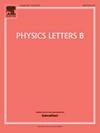Prospects for measuring neutrino mass with 21-cm forest
IF 4.3
2区 物理与天体物理
Q1 ASTRONOMY & ASTROPHYSICS
引用次数: 0
Abstract
Both particle physics experiments and cosmological observations have been used to explore neutrino properties. Cosmological researches of neutrinos often rely on the early-universe cosmic microwave background observations or other late-universe probes, which mostly focus on large-scale structures. We introduce a distinct probe, the 21-cm forest, that differs from other probes in both time and scale. Actually, the 21-cm forest is a unique tool for studying small-scale structures in the early universe. Below the free-streaming scale, massive neutrinos suppress the matter power spectrum, influencing small-scale fluctuations in the distribution of matter. The one-dimensional (1D) power spectrum of the 21-cm forest can track these fluctuations across different scales, similar to the matter power spectrum, providing an effective method to constrain neutrino mass. Although heating effects in the early universe can also impact the 1D power spectrum of the 21-cm forest, we assess the potential of the 21-cm forest as a tool for measuring neutrino mass, given that the temperature of the intergalactic medium can be constrained using other methods within a certain range. In the ideal scenario, the 21-cm forest observation will have the ability to constrain the total neutrino mass to around 0.1 eV. With the accumulation of observational data and advancements in observational technology, the 21-cm forest holds great promise as an emerging and potent tool for measuring neutrino mass.
求助全文
约1分钟内获得全文
求助全文
来源期刊

Physics Letters B
物理-物理:综合
CiteScore
9.10
自引率
6.80%
发文量
647
审稿时长
3 months
期刊介绍:
Physics Letters B ensures the rapid publication of important new results in particle physics, nuclear physics and cosmology. Specialized editors are responsible for contributions in experimental nuclear physics, theoretical nuclear physics, experimental high-energy physics, theoretical high-energy physics, and astrophysics.
 求助内容:
求助内容: 应助结果提醒方式:
应助结果提醒方式:


